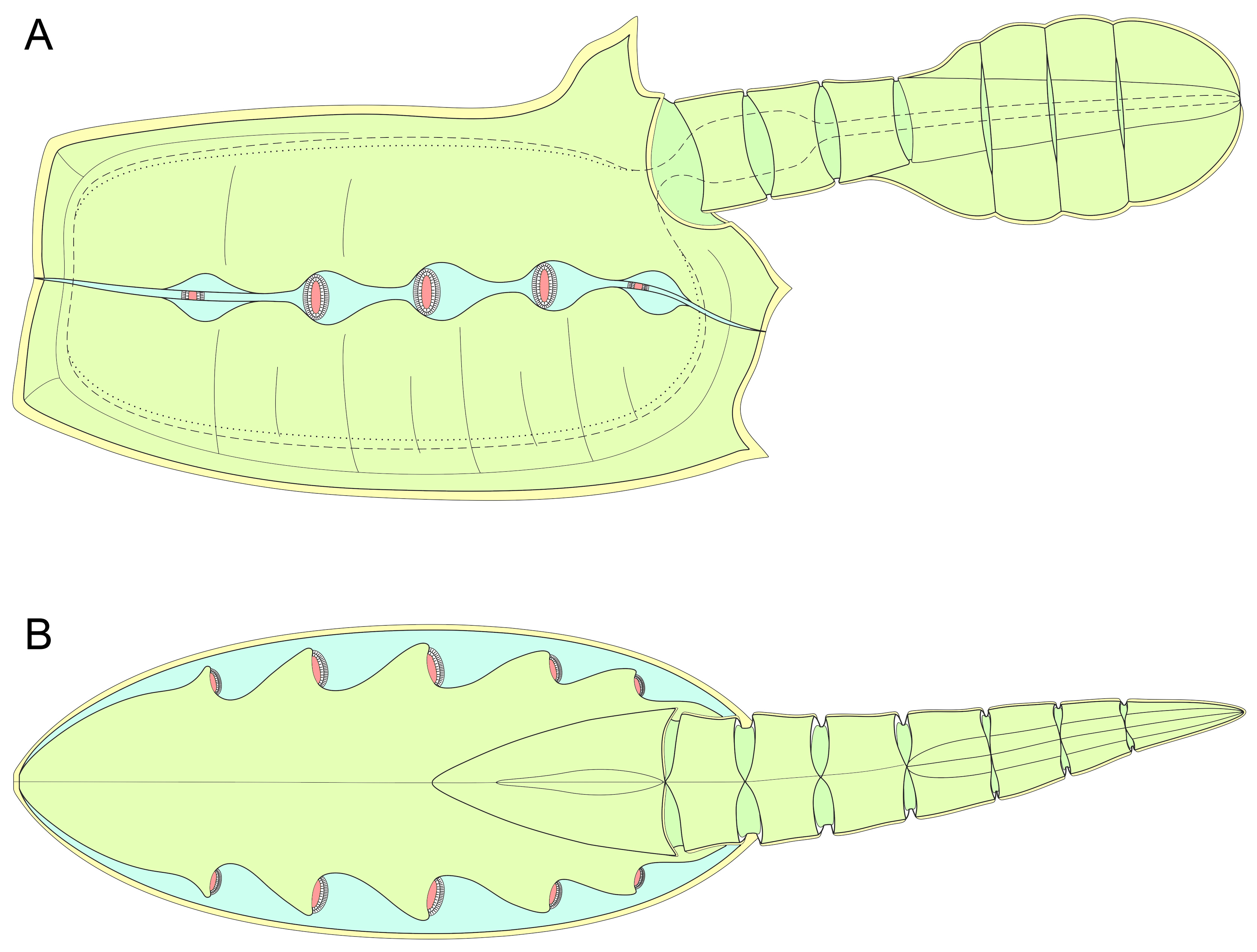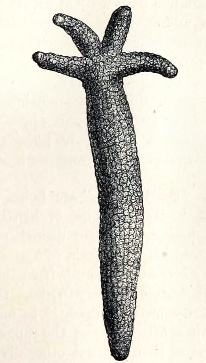|
Ambulacraria
Ambulacraria , or Coelomopora , is a clade of invertebrate phyla that includes echinoderms and hemichordates; a member of this group is called an ambulacrarian. Phylogenetic analysis suggests the echinoderms and hemichordates separated around 533 million years ago. The Ambulacraria are part of the deuterostomes, a clade that also includes the many Chordata, and the few extinct species belonging to the Vetulicolia. Phylogeny The two living clades with representative organisms are: * Echinodermata (sea stars, sea urchins, brittle stars, sea cucumbers, feather stars, sea lilies, etc.) * Hemichordata ( acorn worms (Enteropnuesta) and Pterobranchia (including Graptolithina)) (These together sometimes are called the ''lower deuterostomes''.) Whether the Xenacoelomorpha clade is the sister group to the Ambulacraria remains a contentious issue, with some authors arguing that the former should be placed more basally among metazoans, and other authors asserting that the best choice ... [...More Info...] [...Related Items...] OR: [Wikipedia] [Google] [Baidu] |
Chordates
A chordate ( ) is a bilaterian animal belonging to the phylum Chordata ( ). All chordates possess, at some point during their larval or adult stages, five distinctive physical characteristics ( synapomorphies) that distinguish them from other taxa. These five synapomorphies are a notochord, a hollow dorsal nerve cord, an endostyle or thyroid, pharyngeal slits, and a post- anal tail. In addition to the morphological characteristics used to define chordates, analysis of genome sequences has identified two conserved signature indels (CSIs) in their proteins: cyclophilin-like protein and inner mitochondrial membrane protease ATP23, which are exclusively shared by all vertebrates, tunicates and cephalochordates. These CSIs provide molecular means to reliably distinguish chordates from all other animals. Chordates are divided into three subphyla: Vertebrata (fish, amphibians, reptiles, birds and mammals), whose notochords are replaced by a cartilaginous/ bony axial ... [...More Info...] [...Related Items...] OR: [Wikipedia] [Google] [Baidu] |
Vetulicolia
Vetulicolia is a group of bilaterian marine animals encompassing several extinct species from the Cambrian, and possibly Ediacaran, periods. As of 2023, the majority of workers favor placing Vetulicolians in the stem group of the Chordata, but some continue to favor a more crownward placement as a sister group to the Tunicata. It was initially erected as a monophyletic clade with the rank of phylum in 2001, with subsequent work supporting its monophyly. However, more recent research suggests that vetulicolians may be paraphyletic and form a basal evolutionary grade of stem chordates. Etymology The taxon name, Vetulicolia, is derived from the type genus, '' Vetulicola'', which is a compound Latin word composed of ''vetuli'' "old" and ''cola'' "inhabitant". It was named after '' Vetulicola cuneata'', the first species of the group described in 1987. Description The vetulicolian body plan comprises two parts: a voluminous rostral (anterior) forebody, tipped with an anteri ... [...More Info...] [...Related Items...] OR: [Wikipedia] [Google] [Baidu] |
Echinodermata
An echinoderm () is any animal of the phylum Echinodermata (), which includes starfish, brittle stars, sea urchins, sand dollars and sea cucumbers, as well as the sessile sea lilies or "stone lilies". While bilaterally symmetrical as larvae, as adults echinoderms are recognisable by their usually five-pointed radial symmetry (pentamerous symmetry), and are found on the sea bed at every ocean depth from the intertidal zone to the abyssal zone. The phylum contains about 7,600 living species, making it the second-largest group of deuterostomes after the chordates, as well as the largest marine animal, marine-only phylum. The first definitive echinoderms appeared near the start of the Cambrian. Echinoderms are important both ecologically and geologically. Ecologically, there are few other groupings so abundant in the deep sea, as well as continental shelf, shallower oceans. Most echinoderms are able to asexual reproduction, reproduce asexually and regeneration (biology), regenerat ... [...More Info...] [...Related Items...] OR: [Wikipedia] [Google] [Baidu] |
Xenambulacraria
Xenambulacraria is a proposed clade of animals with bilateral symmetry as an embryo, consisting of the Xenacoelomorpha (i.e., ''Xenoturbella'' and acoelomorphs) and the Ambulacraria (i.e., echinoderms and hemichordates). If confirmed, the clade would either be the sister group to the chordates (if deuterostomes are monophyletic) or the sister group to all the other bilaterians, grouped together in Centroneuralia (with deuterostomes being paraphyletic). Although the validity of the clade relies mostly on phylogenomics, molecular genetics studies have proposed pigment cell clusters expressing polyketide synthase (PKS) and sulfotransferase as a synapomorphy of Xenambulacraria. Phylogeny Xenambulacraria has usually been recovered as a clade inside of either of two distinct phylogenies. Basal Xenambulacraria The following phylogeny assumes a paraphyletic Deuterostomia, with Xenambulacraria at the base of Bilateria. Xenambulacraria inside Deuterostomia The following ph ... [...More Info...] [...Related Items...] OR: [Wikipedia] [Google] [Baidu] |
Echinoderm
An echinoderm () is any animal of the phylum Echinodermata (), which includes starfish, brittle stars, sea urchins, sand dollars and sea cucumbers, as well as the sessile sea lilies or "stone lilies". While bilaterally symmetrical as larvae, as adults echinoderms are recognisable by their usually five-pointed radial symmetry (pentamerous symmetry), and are found on the sea bed at every ocean depth from the intertidal zone to the abyssal zone. The phylum contains about 7,600 living species, making it the second-largest group of deuterostomes after the chordates, as well as the largest marine-only phylum. The first definitive echinoderms appeared near the start of the Cambrian. Echinoderms are important both ecologically and geologically. Ecologically, there are few other groupings so abundant in the deep sea, as well as shallower oceans. Most echinoderms are able to reproduce asexually and regenerate tissue, organs and limbs; in some cases, they can undergo ... [...More Info...] [...Related Items...] OR: [Wikipedia] [Google] [Baidu] |
Deuterostome
Deuterostomes (from Greek: ) are bilaterian animals of the superphylum Deuterostomia (), typically characterized by their anus forming before the mouth during embryonic development. Deuterostomia comprises three phyla: Chordata, Echinodermata, Hemichordata, and the extinct clade Cambroernida. In deuterostomes, the developing embryo's first opening (the blastopore) becomes the anus and cloaca, while the mouth is formed at a different site later on. This was initially the group's distinguishing characteristic, but deuterostomy has since been discovered among protostomes as well. The deuterostomes are also known as enterocoelomates, because their coelom develops through pouching of the gut, enterocoely. Deuterostomia's sister clade is Protostomia, animals that develop mouth first and whose digestive tract development is more varied. Protostomia includes the ecdysozoans and spiralians, as well as the extinct '' Kimberella''. Together with the Xenacoelomorpha, these constit ... [...More Info...] [...Related Items...] OR: [Wikipedia] [Google] [Baidu] |
Metazoan
Animals are multicellular, eukaryotic organisms in the biological kingdom Animalia (). With few exceptions, animals consume organic material, breathe oxygen, have myocytes and are able to move, can reproduce sexually, and grow from a hollow sphere of cells, the blastula, during embryonic development. Animals form a clade, meaning that they arose from a single common ancestor. Over 1.5 million living animal species have been described, of which around 1.05 million are insects, over 85,000 are molluscs, and around 65,000 are vertebrates. It has been estimated there are as many as 7.77 million animal species on Earth. Animal body lengths range from to . They have complex ecologies and interactions with each other and their environments, forming intricate food webs. The scientific study of animals is known as zoology, and the study of animal behaviour is known as ethology. The animal kingdom is divided into five major clades, namely Porifera, Ctenophora, Placozoa, ... [...More Info...] [...Related Items...] OR: [Wikipedia] [Google] [Baidu] |
Vetulocystida
Vetulocystidae is the only family of the taxon Vetulocystida, which is a group of extinct deuterostomes of uncertain phylogenetic position. Vetulocystidae is made up of the genera ''Vetulocystis'', '' Dianchicystis'' and '' Thylacocercus''. Etymology The latin ''vetus'' means "old," while ''cystis'' refers to the organisms' bag-like shape. Description The body consists of a voluminous thecal-shaped section (similar to the outer shape of the pterobranchs), where there are two cone-shaped structures (anterior and posterior) and a lenticular respiratory organ; and another small section attached to the substrate. The anterior cone-shaped structure is believed to have constituted the mouth, due to its similarity to primitive echinoderms (such as stylophorans and blastoids); while the posterior structure (similar to that of the cystoids and eocrinoids) fulfilled the functions of anus and gonopore. Furthermore, and unlike many other echinoderms, these animals lacked a calcified skele ... [...More Info...] [...Related Items...] OR: [Wikipedia] [Google] [Baidu] |
Vetulocystidae
Vetulocystidae is the only family of the taxon Vetulocystida, which is a group of extinct deuterostomes of uncertain phylogenetic position. Vetulocystidae is made up of the genera '' Vetulocystis'', '' Dianchicystis'' and '' Thylacocercus''. Etymology The latin ''vetus'' means "old," while ''cystis'' refers to the organisms' bag-like shape. Description The body consists of a voluminous thecal-shaped section (similar to the outer shape of the pterobranchs), where there are two cone-shaped structures (anterior and posterior) and a lenticular respiratory organ; and another small section attached to the substrate. The anterior cone-shaped structure is believed to have constituted the mouth, due to its similarity to primitive echinoderms (such as stylophorans and blastoids); while the posterior structure (similar to that of the cystoids and eocrinoids) fulfilled the functions of anus and gonopore. Furthermore, and unlike many other echinoderms, these animals lacked a calcified sk ... [...More Info...] [...Related Items...] OR: [Wikipedia] [Google] [Baidu] |
Xenacoelomorpha
Xenacoelomorpha () is a small phylum of bilaterian invertebrate animals, consisting of two sister groups: xenoturbellids and acoelomorphs. This new phylum was named in February 2011 and suggested based on morphological synapomorphies (physical appearances shared by the animals in the clade), which was then confirmed by phylogenomic analyses of molecular data (similarities in the DNA of the animals within the clade). Phylogenetics Prior to molecular studies, xenacoelomorphs were considered to be flatworms based on their superficial similarities. Like flatworms, they do not have a coelom and are dorsoventrally flattened. With the advent of phylogenetics, '' Xenoturbella'' and Acoelomorpha were found to be sister groups and only distantly related to flatworms. Initially this phylum was considered to be a member of the deuterostomes, but because of recent transcriptome analyses, it was concluded that phylum Xenacoelomorpha is the sister group to the Nephrozoa, which includes ... [...More Info...] [...Related Items...] OR: [Wikipedia] [Google] [Baidu] |
Hemichordate
Hemichordata ( ) is a phylum which consists of triploblastic, eucoelomate, and bilaterally symmetrical marine deuterostome animals, generally considered the sister group of the echinoderms. They appear in the Lower or Middle Cambrian and include two main classes: Enteropneusta (acorn worms), and Pterobranchia. A third class, Planctosphaeroidea, is known only from the larva of a single species, '' Planctosphaera pelagica''. The class Graptolithina, formerly considered extinct, is now placed within the pterobranchs, represented by a single living genus '' Rhabdopleura''. Acorn worms are solitary worm-shaped organisms. They generally live in burrows (the earliest secreted tubes) and are deposit feeders, but some species are pharyngeal filter feeders, while the family are free living detritivores. Many are well known for their production and accumulation of various halogenated phenols and pyrroles. Pterobranchs are filter-feeders, mostly colonial, living in a collagenous ... [...More Info...] [...Related Items...] OR: [Wikipedia] [Google] [Baidu] |









